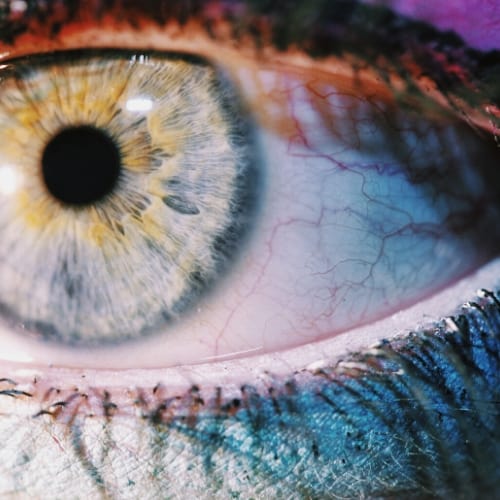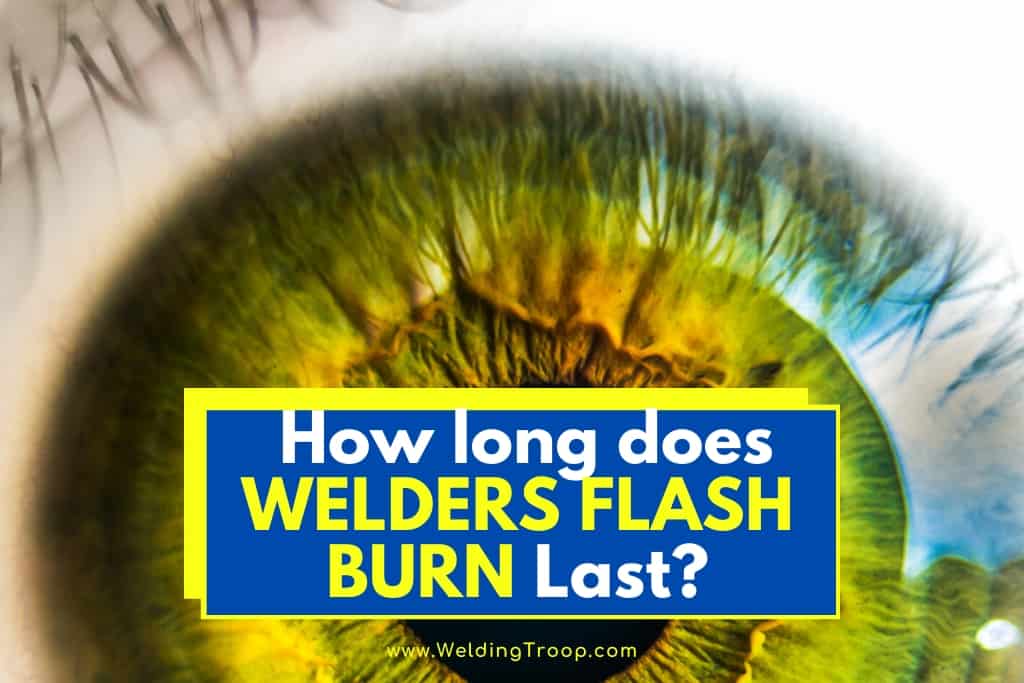Have you ever asked yourself how Long Does Welders Flash Burn Last? We all know that welding can be a dangerous job. When the heat grows intense and the sparks start flying, it is essential that your body, especially your face, is well-protected. The last thing you want is for sparks to fly up and blind you. Even if you take the proper precautions, however, you can still suffer from welder’s flash. It’s just what it sounds like – a bright flash of light resulting from welding that can leave you with vision issues.
How Long Does Welders Flash burn Last? If you have successfully identified your eye issue as welders flash, don’t panic, in most cases, welding flash is very treatable, and last between one or three days. If you still do not see progress, or are still experiencing severe symptoms, tell your doctor immediately.
Table of Contents
What Is Welders Flash?
First off, let’s separate fact from fiction. If you happen to stare at a very bright light for several seconds and find yourself seeing white flashes for a couple of seconds, this isn’t Welder’s flash.
Welder’s flash, Arc-eye, or as it’s scientifically known “Photokeratitis”, is a very painful inflammation of the cornea. The cornea is the small clear outer tissue that protects your eyes. The cornea’s job is to ensure that no dirt, germs, or anything damaging enters the eyes. Any damage that befalls the cornea can really affect the eye-sight if it goes untreated
How Does a Flash Burn Occur?
A flash burn happens when the eyes are directly exposed to extremely bright light, or to bright ultraviolet light. UV light has countless harmful effects on the human skin, but when the eyes are exposed to it, it causes what’s known as Welder’s flash.
While flash burn or welder’s flash can occur when the eyes are exposed to any source of UV light, it’s most commonly associated with welding torches. This is probably why it got its popular name; “Welder’s flash”.
What Does the Welder Flash Do to the Cornea?
Welder’s flash or flash burn, act like a sunburn but to the eyes. They can affect one, or two eyes at the same time. The Welder’s flash basically burns the cornea and thus, causes irritation, redness, and sometimes, can cause the eyes to turn bloodshot.
In most cases, the cornea can self-repair in a couple of days, especially if the infected didn’t put too much strain on their eyes these days. It also usually heals without leaving any scars.
When not treated or if they continue to put too much strain on their eyes, the eyes might get an infection. Infections can be pretty dead serious and might lead to a loss in vision if not treated immediately.
Symptoms and Causes of Welders Flash Burn
First thing’s first – what causes welding flash? The most obvious answer is the flash of bright light and heat that results from welding.
Symptoms
Some of the most common symptoms of welding flash include:
| Nr. | symptoms of welders flash burn |
| 1 | Eye pain, usually beginning a few hours after a welding accident, which can range from minor to quite intense |
| 2 | Heightened sensitivity to light |
| 3 | Watery eyes |
| 4 | Bloodshot eyes |
| 5 | Blurry vision |
| 6 | A sensation as though there is something in your eye |
What Does Welders Flash Feel Like?
Symptoms of Welder’s flash start appearing almost immediately after initial exposure. In most cases, they’ll start appearing right after the person stops looking at the light source.
The first signs include instant eye-pain, swelling or twitching of eyelids, watery eyes, and the eyes turning bloodshot. They might also find the skin around the eyes turning a shade of red.
They might find their eyesight becoming affected as well; cloudiness and haziness are most commonly associated with welder’s flash, especially as first symptoms.
As you might be able to tell, there is at least one major problem with this list from a diagnostic point of view – it’s hardly exclusive to welding flash.
That makes it that much more essential to consider the causes of welding flash. It is typically caused by a bright flash or similar intense exposure to UV light, usually stemming from, among other things:
- Welding torches
- Staring directly at the sun
- Sunlamps
- Halogen photography flashes
Causes of Flash Burn
The direct cause of a flash burn is exposure to UV light, but what causes a person to get exposed to it is what’s important. Most people who get a flash burn, get it because they neglect wearing protective gear when working with material that releases UV light in high doses.
If a person is working in the welding industry or knows someone who does, they would know that it’s always recommended to wear eye gear when working. These types of goggles are specifically produced for this type of industry.
Other than UV light, or working with welding torches, several sources can make someone get a welder’s flash.
Such sources are:
- Sunlight (looking at direct sunlight for a while)
- Sunlight reflection (Water and snow)
- Tanning salons’ sunlamps
- Specific lamps, like the photographer’s flood lamp and the halogen lamp
Related Article: Does Welding Hurt Your Eyes? How Can You Protect Your Eyes
What Happens When One Accidentally Looks at a Welding Arc?
If one doesn’t work in the welding industry, then there’s probably less chance for them to come in contact with welding arcs. If, however, they come across one by chance and they happen to look at it, things might get messy.
In this case, they obviously won’t be wearing the Personal Protective Equipment (PPE) and they might find themselves suffering from the following symptoms:
- Mild to intense pain in eyes
- Slight pressure in their eyes
- Sudden sensitivity to light and inability to look directly at any light source
- Watering of the eyes
- Redness around the eyes and/or bloodshot eyes
- The feeling that something is stuck in their eyes, like grain and sand
There are plenty of things that might affect how severe a flash burn is. These include how far a person was from the UV light source, the duration they spent looking at it, and the angle when looking at the source.
If a person regularly works with welder torches, they must realize that continuous exposure to that light might lead to cataracts. This then might end up costing them their vision.
Diagnosis of Flash Burn
A routine test to check whether someone’s suffering from welder’s flash or not is the slit lamp test. In this test, the doctor will check the eyes for any damage using a microscopic lens.
In some cases, he might include orange dye and a special blue light in his testing, to check the severity of the damage that happened to the cornea. If you’re infected, you don’t need to worry about that orange dye, because it’s pretty harmless and it will get washed away by tears.
Another test that might get performed on is the visual acuity test. In that one, the doctor will inspect the eyes’ movement and the person’s vision.
In short, a regular Flash Burn diagnosis will include:
- Inspection of damage using a microscope
- Usage of an anesthetic drop to numb the eyes
- Orange dye to know how much damage was inflicted on the cornea
- That orange dye is followed by the blue light

Treatment for Flash Burn
The first thing a person must do to do after exposure to UV light is to make their way to an ophthalmologist. It’s best not to wait, and see a doctor as soon as they start experiencing any symptoms.
A Doctor’s Opinion
It’s very important to have a doctor look over the eyes because the damage might come in several ways. There might be bacteria or a mass of foreign bodies around the eyes. These might be what’s causing most of the discomfort in the area, as well as the bloodshot and watery eyes.
If that’s the case, the doctor will prescribe an antibiotic to halt any infections from happening. If the cornea got damaged in the process, the doctor will give the patient dilating drops and padded dressings. These will help in the recovery process.
Following Up
After 24 hours have passed, They might need another visit to the doctor so he can survey their eyes and make sure that they’re well into the healing process. Also, he must find no infections developing.
If that was the case, then the healing process might take a little more time as the doctor will then refer them to a specialist.
Recovery
Normally, the cornea takes about one or two days to fully recover. If they neglect getting treatment for the welder’s flash from a doctor, they might get infections and that will definitely slow down the healing process.
This might lead to Cataract, which then leads to some loss of vision
Common Methods of Treatment
After the initial visit to the doctor, there are some steps one should take to ensure that the healing process is going smoothly. Some of these steps might be right for one person, but not suitable for others, this is why it’s best to consult the doctor before attempting anything.
One of the first remedies is the dilating drops, and these are provided for by the doctor. They’re used to relax the eyes muscles, thus allowing the eyes to heal quickly. One common side effect of using them is that the pupil might get a bit bigger.
Related Article: Personal Protective Equipment for Welders – PPE | List, and Requirements
Side effects don’t normally last for a long time and they usually go away in a couple of hours.
Another treatment includes “Dressing”. This is when the doctor covers the eyes with a special padded dressing that allows the eyes to relax and heal properly. It’s strongly advised against attempting to drive whilst wearing an eye patch.
The doctor might also prescribe antibiotics and that happens if he finds the eyes susceptible to infections. These come in the forms of ointments or eye drops. A doctor’s guidance is very important in this step.

Another thing a doctor might prescribe is an anti-inflammatory drop that has mild steroids in it.
When you treat your pupils with these drops. your pupils will dilate. When this happens, your eyes will be especially sensitive to any kind of light, especially sunlight. As such, you will want to plan your day accordingly.
You should avoid spending the rest of the day outside following this treatment, and if at all possible, you’ll want to have someone drive you home.
In keeping with that, once you get home, you’ll want to do everything possible to ease the strain on your eyes. For example, it is a good idea to keep your eyes shaded, covered, and potentially pad them with a dressing to help the healing process along.
Some tips for using eye drops for welding flash include:
| Nr. | Tips |
| 1 | Make sure to wash your hands |
| 2 | Gently rest your finger against your cheek and pull down on your lower eyelid |
| 3 | Tilt your head so that the drops are directly above your eyes |
| 4 | Make sure the nozzle of the eye dropper doesn’t touch your eye |
Prevention of Welders Flash
Treatment of any disease, especially in a vulnerable part of the body like the eyes, often includes pain and discomfort. That’s why prevention is always recommended.
Some of the ways you can prevent getting a welder’s flash include:
- Wearing protective gear when dealing with anything that emits UV light
- When welding, you must wear a protective mask
- In normal day-to-day activities, try wearing sunglasses that protect against UV light
- Avoid looking at direct sunlight for a long period
Some additional welding flash self-care tips include:
| Nr. | Welding Flash Burn Care Tips |
| 1 | If the pain remains intense, you may want to take pain relief medication such as codeine, ibuprofen, or paracetamol |
| 2 | Make sure to use any pain relief pills safely, and always follow the dosage instructions on the packet or bottle |
| 3 | Avoid wearing contact lenses until your eyes are fully healed |
| 4 | Avoid going out, but if you must leave the home, wear sunglasses |
| 5 | Artificial tears and lubricants can also help ease discomfort |
Make sure to schedule a follow-up appointment with your doctor for a few days to a week or two after treatment begins to make sure that it is progressing properly.
Welding flash may be scary, but by following these tips, you can regain full pain-free use of your eyes “in a flash.”
Taking Care of Yourself at Home After a Flash Burn
Relaxation is needed when resting after a flash burn. Some things can be done at home to prevent things from going south. We’ve compiled a couple of tips on how to take care of yourself or of a loved one if you/they get a welder’s flash.
- Pain-relieving medication can really help, consult your doctor about which one to use
- If you use contact lenses, avoid using them during the healing period
- If you feel any discomfort in your eyes, try using lubricants and/or artificial tears
- Wear sunglasses when going into the sunlight.
- If your doctor calls for a check-up visit, you must follow up
Conclusion
In short, a welder’s flash is a painful ailment that happens when the eyes are directly exposed to UV light. It’s relatively common among welders because they work with machinery that emits UV light.
When someone is welding, the torch will emit that harmful light which then can cause the cornea to burn. This can then bring about infections, inflammation, and bloodshot eyes.
Recommended Reading
Is Welding a Hard Job? | All Facts You Need To Know
Does Welding Cause Cancer? | How to protect yourself while welding
Do Welders Get Drug Tested? | All Facts You Need To Know
5 Home Remedies To Treat Welder’s Flash – Eye Pain >> Video
Here are some of my favorite tools & equipment´s
Thank you for reading this article. I hope it helps you find the most recent and accurate information for your welding project. Here are some tools that I use daily and hope you´ll also find helpful.
There are affiliate links, so if you do decide to use any of them, I´ll earn a small commission. But in all honesty, these are the exact tools that I use and recommend to everyone, even my own family. (NO CRAP)
To see all my of most up-to-date recommendations, check out this resource that I made for you!


